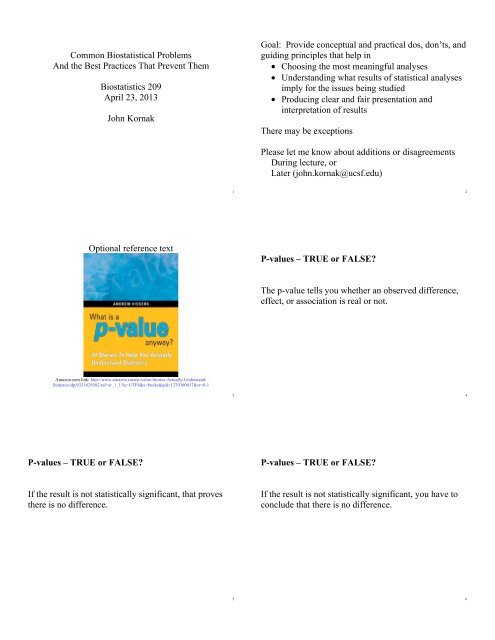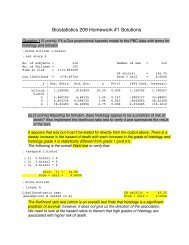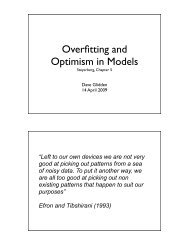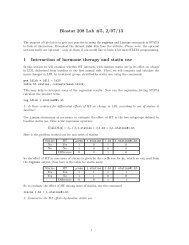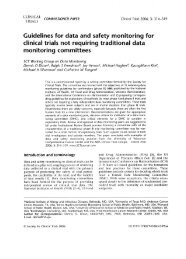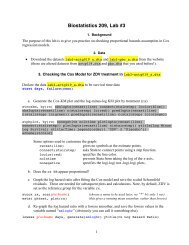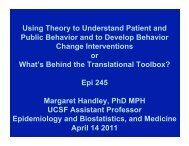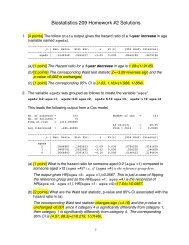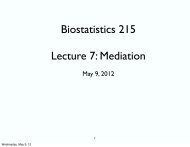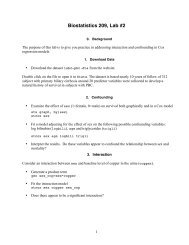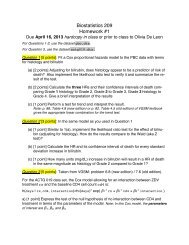Common Biostatistical Problems And the Best Practices That ...
Common Biostatistical Problems And the Best Practices That ...
Common Biostatistical Problems And the Best Practices That ...
Create successful ePaper yourself
Turn your PDF publications into a flip-book with our unique Google optimized e-Paper software.
<strong>Common</strong> <strong>Biostatistical</strong> <strong>Problems</strong><br />
<strong>And</strong> <strong>the</strong> <strong>Best</strong> <strong>Practices</strong> <strong>That</strong> Prevent Them<br />
Biostatistics 209<br />
April 23, 2013<br />
John Kornak<br />
Goal: Provide conceptual and practical dos, don’ts, and<br />
guiding principles that help in<br />
• Choosing <strong>the</strong> most meaningful analyses<br />
• Understanding what results of statistical analyses<br />
imply for <strong>the</strong> issues being studied<br />
• Producing clear and fair presentation and<br />
interpretation of results<br />
There may be exceptions<br />
Please let me know about additions or disagreements<br />
During lecture, or<br />
Later (john.kornak@ucsf.edu)<br />
1<br />
2<br />
Optional reference text<br />
P-values – TRUE or FALSE?<br />
The p-value tells you whe<strong>the</strong>r an observed difference,<br />
effect, or association is real or not.<br />
Amazon.com link: http://www.amazon.com/p-value-Stories-Actually-Understand-<br />
Statistics/dp/0321629302/ref=sr_1_1?ie=UTF8&s=books&qid=1270360017&sr=8-1<br />
3<br />
4<br />
P-values – TRUE or FALSE?<br />
P-values – TRUE or FALSE?<br />
If <strong>the</strong> result is not statistically significant, that proves<br />
<strong>the</strong>re is no difference.<br />
If <strong>the</strong> result is not statistically significant, you have to<br />
conclude that <strong>the</strong>re is no difference.<br />
5<br />
6
Problem 1. P-values for establishing negative<br />
conclusions<br />
The P-value Fallacy:<br />
How about:<br />
p>0.05 + Power Calculation = No effect<br />
The p-value tells you whe<strong>the</strong>r an observed difference,<br />
effect, or association is real or not.<br />
If <strong>the</strong> result is not statistically significant, that proves<br />
<strong>the</strong>re is no difference.<br />
If <strong>the</strong> result is not statistically significant, you have to<br />
conclude that <strong>the</strong>re is no difference.<br />
-- ALL FALSE<br />
7<br />
8<br />
How about:<br />
p>0.05 + Power Calculation = No effect<br />
Still no good!<br />
Reasoning via p-values and power is convoluted and<br />
unreliable.<br />
Power calculations are usually inaccurate. A study of<br />
RCTs in 4 top medical journals found more than half<br />
used assumed SD’s off by enough to produce >2-fold<br />
differences in sample size.<br />
CONSORT guidelines: “There is little merit in a post<br />
hoc calculation of statistical power using <strong>the</strong> results of a<br />
trial”.<br />
Confidence intervals show simply and directly what<br />
possibilities are reasonably consistent with <strong>the</strong> observed<br />
data.<br />
9<br />
10<br />
Additional references:<br />
1958, D.R. Cox: “Power . . . is quite irrelevant in <strong>the</strong><br />
actual analysis of data.”<br />
Goodman SN, Berlin JA. The use of predicted<br />
confidence intervals when planning experiments and<br />
<strong>the</strong> misuse of power when interpreting results. Ann<br />
Intern Med 1994; 121:200-6.<br />
Hoenig JM, Heisey DM. The abuse of power: <strong>the</strong><br />
pervasive fallacy of power calculations for data<br />
analysis. American Statistician. 2001;55:19-34.<br />
Bacchetti P. Current sample size conventions: flaws,<br />
harms, and alternatives. BMC Medicine, 8:17, 2010.<br />
How about:<br />
p>0.05 + Large N = No effect<br />
p>0.05 + Huge Expense = No effect<br />
p>0.05 + Massive Disappointment = No Effect<br />
11<br />
12
How about:<br />
p>0.05 + Large N = No effect<br />
p>0.05 + Huge Expense = No effect<br />
p>0.05 + Massive Disappointment = No Effect<br />
Example: Treatment of an acute infection<br />
Treatment A: 16 deaths in 100<br />
Treatment B: 8 deaths in 100<br />
Odds ratio: 2.2, CI 0.83 to 6.2, p=0.13<br />
Risk difference: 8.0%, CI -0.9% to 16.9%<br />
Not if contradicted by <strong>the</strong> CI’s!<br />
Confidence intervals show simply and directly what<br />
possibilities are reasonably consistent with <strong>the</strong> observed<br />
data.<br />
13<br />
14<br />
Example: Treatment of an acute infection<br />
Treatment A: 16 deaths in 100<br />
Treatment B: 8 deaths in 100<br />
Odds ratio: 2.2, CI 0.83 to 6.2, p=0.13<br />
Risk difference: 8.0%, CI -0.9% to 16.9%<br />
“No difference in death rates”<br />
“No significant difference in death rates”<br />
“No statistical difference in death rates”<br />
Example: Treatment of an acute infection<br />
Treatment A: 16 deaths in 100<br />
Treatment B: 8 deaths in 100<br />
Odds ratio: 2.2, CI 0.83 to 6.2, p=0.13<br />
Risk difference: 8.0%, CI -0.9% to 16.9%<br />
“Our study suggests an important benefit of<br />
Treatment B, but this did not reach statistical<br />
significance.”<br />
15<br />
16<br />
NEJM, 354: 1796-1806, 2006.<br />
“Supplementation with vitamins C and E during<br />
pregnancy does not reduce <strong>the</strong> risk of preeclampsia in<br />
nulliparous women, <strong>the</strong> risk of intrauterine growth<br />
restriction, or <strong>the</strong> risk of death or o<strong>the</strong>r serious<br />
outcomes in <strong>the</strong>ir infants.”<br />
Preeclampsia: RR 1.20 (0.82 – 1.75)<br />
Growth restriction: RR 0.87 (0.66 – 1.16)<br />
Serious outcomes: RR 0.79 (0.61 – 1.02)<br />
Women’s Health Initiative study on fat consumption<br />
and breast cancer<br />
Invasive Breast Cancer<br />
HR 0.91 (0.83-1.01),<br />
p=0.07<br />
Breast Cancer Mortality<br />
HR 0.77 (0.48-1.22)<br />
From JAMA abstract:<br />
“a low-fat dietary pattern<br />
did not result in a<br />
statistically significant<br />
reduction in invasive<br />
breast cancer risk”<br />
17<br />
18
<strong>Best</strong> Practice 1. Provide estimates—with confidence<br />
intervals—that directly address <strong>the</strong> issues of interest.<br />
Often followed (but <strong>the</strong>n ignored when interpreting)<br />
BP2. Ensure that major conclusions reflect <strong>the</strong><br />
estimates and <strong>the</strong> uncertainty around <strong>the</strong>m.<br />
BP2a. Never interpret large p-values as establishing<br />
negative conclusions.<br />
The estimate is <strong>the</strong> value most supported by <strong>the</strong> data<br />
The confidence interval includes values that are not too<br />
incompatible with <strong>the</strong> data<br />
The study provides strong evidence against values<br />
outside <strong>the</strong> CI<br />
19<br />
20<br />
NEJM, 354: 1889-1900, 2006<br />
Conclusion: “When treated with photo<strong>the</strong>rapy or<br />
exchange transfusion, total serum bilirubin levels in <strong>the</strong><br />
range included in this study were not associated with<br />
adverse neurodevelopmental outcomes in infants born<br />
at or near term.”<br />
Support: “on most tests, 95 percent confidence<br />
intervals excluded a 3-point (0.2 SD) decrease in<br />
adjusted scores in <strong>the</strong> hyperbilirubinemia group.”<br />
What if results are less conclusive?<br />
Growth restriction: RR 0.87 (0.66 – 1.16)<br />
Serious outcomes: RR 0.79 (0.61 – 1.02)<br />
“Our results suggest that Vitamin C and E<br />
supplementation may substantially reduce <strong>the</strong> risk of<br />
growth restriction and <strong>the</strong> risk of death or o<strong>the</strong>r serious<br />
outcomes in <strong>the</strong> infant, but confidence intervals were<br />
too wide to rule out <strong>the</strong> possibility of no effect.”<br />
21<br />
22<br />
But <strong>the</strong>n <strong>the</strong> paper probably won’t end up in NEJM!<br />
The “elephant in <strong>the</strong> room” when it comes to conflict of<br />
interest:<br />
- We are all under pressure to make our papers seem<br />
as interesting as possible.<br />
BP3. Discuss <strong>the</strong> implications of your findings for<br />
what may be true in general. Do not focus on<br />
“statistical significance” as if it were an end in itself.<br />
The p-value fallacy can help make “negative” studies<br />
seem more conclusive and interesting.<br />
Be vigilant (and be honest)!<br />
23<br />
24
WHI conclusion:<br />
“a low-fat dietary pattern did not result in a statistically<br />
significant reduction in invasive breast cancer risk<br />
… However, <strong>the</strong> nonsignificant trends … indicate that<br />
longer, planned, nonintervention follow-up may yield a<br />
more definitive comparison.”<br />
Newsweek followup article:<br />
“The conclusion of <strong>the</strong> breast-cancer study—that a lowfat<br />
diet did not lower risk—was fairly nuanced. It<br />
suggested that if <strong>the</strong> women were followed for a longer<br />
time, <strong>the</strong>re might be more of an effect.”<br />
Easy to slip into relying on “p>” reasoning<br />
• Yes or No reasoning more natural<br />
• Focus on p-values engrained in research culture<br />
• Real level of uncertainty often inconveniently large,<br />
which can make results seem less interesting<br />
Be vigilant<br />
• Double-check all negative interpretations<br />
• Examine estimates, confidence intervals<br />
25<br />
26<br />
How to check negative interpretations:<br />
Perform searches for words “no” and “not”<br />
Clinically Significant Benefit<br />
Clinically Significant Harm<br />
Check each negative interpetation found<br />
- Is <strong>the</strong>re an estimate and CI supporting this?<br />
- What if <strong>the</strong> estimate were exactly right?<br />
- What if <strong>the</strong> upper confidence bound were true?<br />
- What if <strong>the</strong> lower confidence bound were true?<br />
0.2 0.3 0.5 0.7 1.0 1.3 2.0 3.0 4.0<br />
Relative Risk<br />
We found strong evidence against any substantial harm<br />
or benefit.<br />
Additional searches: “failed”, “lack”, “absence”,<br />
“disappeared”, “only”, “ra<strong>the</strong>r”, “nei<strong>the</strong>r”, “none”<br />
27<br />
28<br />
Clinically Significant Benefit<br />
Clinically Significant Harm<br />
Clinically Significant Benefit<br />
Clinically Significant Harm<br />
0.2 0.3 0.5 0.7 1.0 1.3 2.0 3.0 4.0<br />
Relative Risk<br />
Suggestion of substantial benefit<br />
May be no effect (not statistically significant)<br />
0.2 0.3 0.5 0.7 1.0 1.3 2.0 3.0 4.0<br />
Relative Risk<br />
Strong evidence of benefit (statistically significant)<br />
Substantial benefit appears likely, but CI too wide to<br />
rule out clinically unimportant benefit<br />
29<br />
30
Clinically Significant Benefit<br />
Clinically Significant Harm<br />
Clinically Significant Benefit<br />
Clinically Significant Harm<br />
0.2 0.3 0.5 0.7 1.0 1.3 2.0 3.0 4.0<br />
Relative Risk<br />
Strong evidence of substantial clinical benefit<br />
0.2 0.3 0.5 0.7 1.0 1.3 2.0 3.0 4.0<br />
Relative Risk<br />
No conclusions possible due to very wide CI<br />
Also see online resource<br />
http://ctspedia.org/do/view/CTSpedia/ResultsInterpretation<br />
31<br />
32<br />
Example from a typical collaboration:<br />
First draft text:<br />
“There were no statistically significant effects of<br />
DHEA on lean body mass, fat mass or bone density.”<br />
Final wording:<br />
“Estimated effects of DHEA on lean body mass, fat<br />
mass, and bone density were small, but <strong>the</strong> confidence<br />
intervals around <strong>the</strong>m were too wide to rule out effects<br />
large enough to be important.”<br />
Are large p-values good for anything?<br />
“Due diligence” situations<br />
Checking for possible assumption violations when little<br />
suspicion<br />
Just need to state that you checked and nothing jumped<br />
out; don’t need to prove that no violation was possible:<br />
“We note that <strong>the</strong> confidence intervals were not narrow<br />
enough to rule out potentially important interactions,<br />
but in <strong>the</strong> absence of strong evidence for such<br />
interactions we focus on <strong>the</strong> simpler models without<br />
<strong>the</strong>m.”<br />
33<br />
34<br />
Problem 2. Misleading and vague phrasing<br />
We failed to detect …<br />
Our results do not support …<br />
We found no evidence for …<br />
Our data did not confirm …<br />
“There is no scientific evidence that BSE [Mad Cow<br />
Disease] can be transmitted to humans or that eating<br />
beef causes it in humans.”<br />
-- British Prime Minister John Major, 1995<br />
BP4. State what you did find or learn, not what you<br />
didn’t.<br />
This prevents deception, but also can make statements<br />
clearer and stronger.<br />
Oddly, investigators often understate <strong>the</strong>ir conclusions<br />
using weak phrasing.<br />
35<br />
36
FRAM, nationwide study of fat abnormalities in<br />
persons with HIV<br />
Peripheral fat loss association with central fat gain,<br />
OR: 0.71, CI: 0.47 to 1.06, P = 0.10.<br />
First draft: “our results do not support <strong>the</strong> existence of a<br />
single syndrome with reciprocal findings.”<br />
Safety of cannabinoids in persons with treated HIV<br />
Marijuana effect on log 10 VL: -0.06 (-0.26 to 0.13)<br />
Dronabinol: -0.07 (-0.24 to 0.06)<br />
First draft: “Overall <strong>the</strong>re was no evidence that<br />
cannabinoids increased HIV RNA levels over <strong>the</strong> 21-<br />
day study period.”<br />
Final: “We found evidence against any reciprocal<br />
increase in VAT in HIV-infected persons with<br />
peripheral lipoatrophy”<br />
37<br />
Final: “This study provides evidence that shortterm<br />
use of cannabinoids, ei<strong>the</strong>r oral or smoked,<br />
does not substantially elevate viral load in<br />
individuals with HIV infection.”<br />
38<br />
Problem 3. Speculation about low power<br />
“There were departures from <strong>the</strong> design assumptions<br />
that likely reduced study power.<br />
…<br />
“If <strong>the</strong> WHI design assumptions are revised to take into<br />
account <strong>the</strong>se departures [less dietary fat reduction],<br />
projections are that breast cancer incidence in <strong>the</strong><br />
intervention group would be 8% to 9% lower than in <strong>the</strong><br />
comparison group [and] <strong>the</strong> trial would be somewhat<br />
underpowered (projected power of approximately 60%)<br />
to detect a statistically significant difference, which is<br />
consistent with <strong>the</strong> observed results.”<br />
What are <strong>the</strong>y trying to say?<br />
There might be a 9% reduction in risk. We could have<br />
missed it because power was only 60%.<br />
But HR = 0.91, so of course a 9% reduction is possible.<br />
It’s what <strong>the</strong>y actually saw!<br />
BP2. Ensure that major conclusions reflect <strong>the</strong><br />
estimates and <strong>the</strong> uncertainty around <strong>the</strong>m.<br />
39<br />
40<br />
Problem 4. Exclusive reliance on intent-to-treat<br />
analysis<br />
‘Negative’ study of vitamin E in diabetics (JAMA 2005)<br />
“To reduce bias, we included continuing followup from<br />
those who declined active participation in <strong>the</strong> study<br />
extension and stopped taking <strong>the</strong> study medication.”<br />
WHI: Estimate of effect if adherent to low-fat diet:<br />
Breast cancer HR 0.85 (0.71 – 1.02)<br />
Use of more stringent adherence definition “leads to<br />
even smaller HR estimates and to 95% CIs that exclude<br />
1.”<br />
But ITT produces underestimates of actual biological<br />
effects: it is biased toward no effect.<br />
41<br />
42
BP5. Learn as much as you can from your data.<br />
BP5a. Also consider per-protocol analyses, especially<br />
if:<br />
• Interest in biological issues<br />
• Double-blinded treatment<br />
BP5b. Consider advanced methods to estimate causal<br />
effects.<br />
Problem 5. Reliance on omnibus tests<br />
Problem 6. Overuse of multiple comparisons<br />
adjustments<br />
Omnibus tests (like ANOVA)<br />
• check for any one or more of a large number of<br />
possible departures from a global null hypo<strong>the</strong>sis<br />
(nothing is happening anywhere)<br />
• inherently focused only on p-values (Problem 1)<br />
• diffuse, so weaker for specific issues<br />
Multiple comparisons adjustments<br />
• each result detracts from <strong>the</strong> o<strong>the</strong>r<br />
43<br />
44<br />
Investigator’s panicked inquiry:<br />
Animal experiment that included<br />
• a condition that just confirms that <strong>the</strong> experiment<br />
was done correctly<br />
• some places where different conditions should be<br />
similar<br />
• some conditions that should differ<br />
Saw expected results in pairwise comparisons, but<br />
“ANOVA says that <strong>the</strong>re is nothing happening”<br />
Reviewer’s comment on a study examining effects of 4<br />
different administration routes<br />
“Repeated measures analysis of variance should be<br />
completed. Only if <strong>the</strong> time-by-treatment interaction is<br />
significant, should time-specific comparisons be made.<br />
Then multiple comparison procedures, such as Tukey's<br />
test, should be used ra<strong>the</strong>r than repeated t tests.”<br />
This would treat p>0.05 on <strong>the</strong> unfocused omnibus test<br />
of time-by-treatment interaction as a reliable indicator<br />
that no important differences are present—Problem 1.<br />
45<br />
46<br />
Study of biology of morphine addiction:<br />
Very complex design involving:<br />
• two different receptors<br />
• antagonists<br />
• different brain regions with and w/o certain receptor<br />
• systemic vs local administration<br />
Results of many pairwise comparisons fit a biologically<br />
coherent pattern.<br />
47<br />
Reviewer: “The statistical analyses are naïve. The<br />
authors compute what appear to be literally dozens of t-<br />
tests without any adjustment to <strong>the</strong> alpha level ---<br />
indeed <strong>the</strong> probability of obtaining false positives<br />
grows with <strong>the</strong> number of such tests computed. The<br />
authors should have conducted ANOVAs followed by<br />
<strong>the</strong> appropriate post-hoc tests. Their decision to simply<br />
compute t-tests on all possible combinations of means<br />
is statistically unacceptable.”<br />
But <strong>the</strong> probability of obtaining multiple positive<br />
results exactly where expected and negative results<br />
exactly where expected does not grow; it becomes<br />
vanishingly small.<br />
48
BP6. Base interpretations on a syn<strong>the</strong>sis of statistical<br />
results with scientific considerations.<br />
Problem 7. Entangled outcomes and predictors<br />
Body mass index as a “predictor” of central fat<br />
BP6a. Rely on scientific considerations to guard<br />
against overinterpretation of isolated findings with<br />
p
Showing inadequate or excessive precision<br />
• too little ⇒ reader wonders how big exactly<br />
• too much ⇒ false impression of precision (naïve)<br />
• p-values 2 significant digits, HR’s 2 decimals if <<br />
2.0 and one if ≥ 2.0<br />
• do not give p=NS or p>0.1 – encourages p-value<br />
fallacy<br />
• do not show χ 2 , F statistics – give nothing over p-<br />
value<br />
Poorly scaled predictors<br />
• e.g., don’t look at age effects per day… in particular<br />
HR’s difficult to convert in <strong>the</strong> readers head.<br />
Terms likely to be misread<br />
• especially “significant” – use “statistically<br />
significant”, or if implying more general definition<br />
use “important”, “substantial”, or (best) “clinically<br />
significant” – if journal insists on “significant” for<br />
“statistically significant” try to avoid completely.<br />
• use “relative hazard” or “hazard ratio” for<br />
proportional hazards models – NOT “relative risk” –<br />
latter used for relative risk modeling of binary<br />
outcomes.<br />
55<br />
56<br />
• Use “Mann-Whitney” or “Wilcoxon rank-sum” not<br />
“Wilcoxon” to avoid confusion with “Wilcoxon<br />
signed-rank”.<br />
Missing Data<br />
• can cause bias -- depends on why missing<br />
• e.g., those with <strong>the</strong> riskiest behavior may be more<br />
inclined to skip questions about risk factors.<br />
Prevention is best, o<strong>the</strong>rwise<br />
• clearly disclose how much<br />
• give reasons when known<br />
• assess differences in o<strong>the</strong>r variables of nonresponders<br />
• perform sensitivity analyses – compare different<br />
assumptions for <strong>the</strong> missing data. Do conclusions<br />
change?<br />
57<br />
58<br />
• consider advanced methods, e.g., Stata can perform<br />
multiple imputation (see <strong>the</strong> mi command and<br />
http://www.ats.ucla.edu/stat/stata/Library/ice.htm).<br />
You will likely need help from a statistician to use<br />
such approaches.<br />
• when comparing single and multiple predictor<br />
model results, use same set of observations.<br />
Homework<br />
Examine <strong>the</strong> two assigned papers<br />
Look for:<br />
• use of best practices, o<strong>the</strong>r strengths<br />
• problems<br />
• missed opportunities for using best practices<br />
Think about what would have been better and <strong>the</strong><br />
practical or scientific consequences<br />
We will discuss <strong>the</strong>se on Thursday<br />
59<br />
60
Written Homework<br />
Due before class on Thursday 4/19<br />
Choose one paper and<br />
Describe occurrence of one of <strong>the</strong> problems. Quote<br />
text or pinpoint specific results or passages to clearly<br />
identify what you discuss. What should have been<br />
done to avoid <strong>the</strong> problem?<br />
Heisler M, Faul JD, Hayward RA, Langa KM, Blaum<br />
C, Weir D. Mechanisms for Racial and Ethnic<br />
Disparities in Glycemic Control in Middle-aged and<br />
Older Americans in <strong>the</strong> Health and Retirement Study.<br />
Arch Intern Med 2007; 167:1853-1860.<br />
Homsy J, Bunnell R, Moore D, King R, Malamba S, et<br />
al. Reproductive Intentions and Outcomes among<br />
Women on Antiretroviral Therapy in Rural Uganda: A<br />
Prospective Cohort Study. PLoS ONE 2009; 4(1):<br />
e4149.<br />
61<br />
62<br />
Summary of <strong>Problems</strong><br />
Problem 1. P-values for establishing negative<br />
conclusions<br />
Problem 2. Misleading and vague phrasing<br />
Problem 3. Speculation about low power<br />
Problem 4. Exclusive reliance on intent-to-treat<br />
analysis<br />
Problem 5. Reliance on omnibus tests<br />
Problem 6. Overuse of multiple comparisons<br />
adjustments<br />
Problem 7. Entangled outcomes and predictors<br />
Summary of <strong>Biostatistical</strong> <strong>Best</strong> <strong>Practices</strong><br />
BP1. Provide estimates—with confidence intervals—<br />
that directly address <strong>the</strong> issues of interest.<br />
BP2. Ensure that major conclusions reflect <strong>the</strong><br />
estimates and <strong>the</strong> uncertainty around <strong>the</strong>m.<br />
BP2a. Never interpret large p-values as establishing<br />
negative conclusions.<br />
BP3. Discuss <strong>the</strong> implications of your findings for<br />
what may be true in general. Do not focus on<br />
“statistical significance” as if it were an end in itself.<br />
BP4. State what you did find or learn, not what you<br />
didn’t.<br />
63<br />
64<br />
Summary of <strong>Biostatistical</strong> <strong>Best</strong> <strong>Practices</strong><br />
BP5. Learn as much as you can from your data.<br />
BP5a. Also consider per-protocol analyses, especially<br />
if:<br />
• Interest in biological issues<br />
• Double-blinded treatment<br />
BP6. Base interpretations on a syn<strong>the</strong>sis of statistical<br />
results with scientific considerations.<br />
BP6a. Rely on scientific considerations to guard<br />
against overinterpretation of findings with p
Specific exercise for written projects:<br />
Perform searches for words “no” and “not”<br />
Check each sentence found<br />
- Is <strong>the</strong>re an estimate and CI supporting this?<br />
- What if <strong>the</strong> point estimate were exactly right?<br />
- What if <strong>the</strong> upper confidence bound were true?<br />
- What if <strong>the</strong> lower confidence bound were true?<br />
Additional searches: “failed”, “lack”, “absence”,<br />
“disappeared”, “only”, “ra<strong>the</strong>r”, “nei<strong>the</strong>r”, “none”<br />
Also for your written projects<br />
Try to avoid <strong>the</strong> o<strong>the</strong>r problems and follow <strong>the</strong> best<br />
practices<br />
(Or be clear on why your case is an exception)<br />
Take advantage of <strong>the</strong> faculty help that is available<br />
67<br />
68


